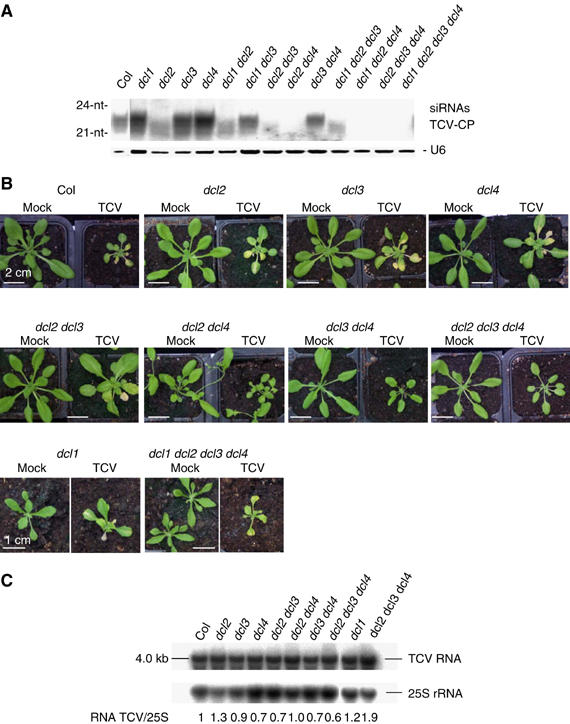Figure 8.

DCL4 and DCL2 produce TCV siRNAs. (A) RNA gel blot analysis of 15 μg total RNA prepared from rosette leaves of wild-type Col, dcl1, dcl2, dcl3 and dcl4 single mutants, dcl1 dcl2, dcl1 dcl3, dcl2 dcl3, dcl2 dcl4, dcl3 dcl4 double mutants, dcl1 dcl2 dcl3, dcl1 dcl2 dcl4, dcl2 dcl3 dcl4 triple mutants and dcl1 dcl2 dcl3 dcl4 quadruple mutant infected with TCV. Plants were grown for 10 days in vitro, transferred to soil, inoculated the day after, and RNAs were extracted from pools of 2–10 plants, 21 days after inoculation. The blots were probed with antisense radiolabeled RNAs probes transcripted in vitro complementary to the region coding for the coat protein of TCV. U6 served as a loading control. (B) 31-day-old wild-type dcl2, dcl3, dcl4, dcl2 dcl3, dcl2 dcl4, dcl3 dcl4, dcl2 dcl3 dcl4, dcl1, dcl1 dcl2 dcl3 dcl4 mutants were sowed in vitro, grown for 10 days under standard conditions, transferred to soil, and inoculated the day after with TCV. Photographs were taken 21 days later. (C) High molecular weight RNA blot analysis of 5 μg total RNA prepared from wild-type Col, dcl1, dcl2, dcl3 and dcl4 single mutants, dcl2 dcl3, dcl2 dcl4 and dcl3 dcl4 double mutants, dcl2 dcl3 dcl4 triple mutants and dcl1 dcl2 dcl3 dcl4 quadruple mutant infected with TCV. Total RNA was extracted from a pool of 2–10 TCV-infected plants 21 days after inoculation. This experiment was repeated three times and one representative experiment is shown. Blots were probed with radiolabeled DNAs complementary to the region coding for the coat protein of TCV. 25S RNA served as a loading control.
